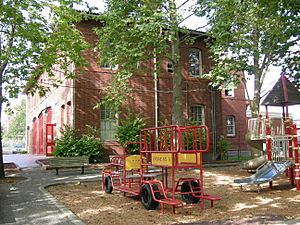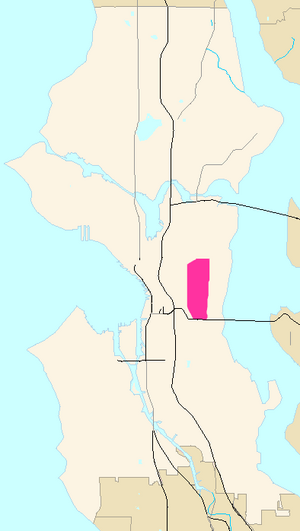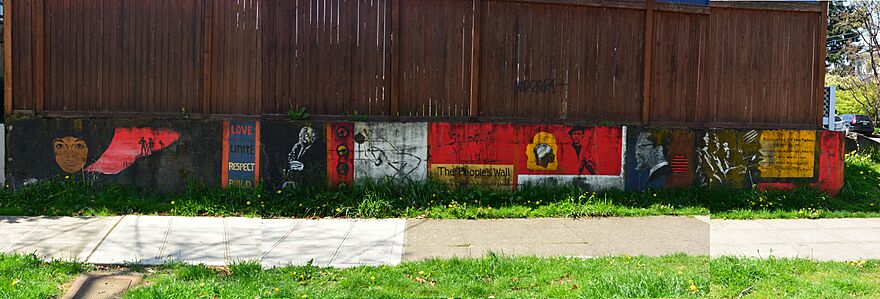Central District, Seattle facts for kids
Quick facts for kids
Central District, Seattle
|
|
|---|---|
|
Seattle Neighborhood
|
|

Firehouse Mini Park and the Cherry Hill Community Center: the former Firehouse No. 23, headquarters of the Central Area Motivation Program. The building is on the National Register of Historic Places.
|
|
| Nicknames:
Central Area, CD
|
|

Central District Highlighted in Pink
|
|
| Country | United States |
| State | Washington |
| County | King |
| City | Seattle |
| Zip Code |
98122
|
| Area Code | 206 |
The Central Area (also called the Central District or The CD) is a neighborhood in Seattle, Washington. It is mostly a place where people live. You can find it east of downtown and First Hill. It is also west of Madrona, Leschi, and Mt. Baker. To the south is Rainier Valley, and to the north is Capitol Hill. For a long time, the Central District has been known for its many different cultures and people. It was once the main area for Seattle's Black community and a center for African-American businesses.
Contents
Exploring the Central District's Past
The Central District has changed a lot over the years. Different groups of people have moved in and shaped the area.
Early Days and Growth
In 1882, a businessman named William Grose bought a large piece of land here. He was already well-known in Seattle. Grose helped make the Central District a home for African-American families. He sold parts of his land to other Black families. He also had a small farm where he grew food for his hotel downtown. At that time, the area was very wooded and grew slowly.
In 1889, the Madison Street Cable Car started running. This made it easier for more Black families to move into the area. Some people say that after more Black families arrived, many white families moved out.
Changes in the Early 1900s
Around 1927, some white homeowners tried to create rules that would make it hard for certain people to buy or rent homes in the area. This was different from other places because the Central District already had African-American, Jewish, and Asian families living there. These rules tried to keep certain groups of people from moving to other parts of the city.
In the early 1900s, the Central District also became a big home for Jewish families. They built Temple De Hirsch on Union Street in 1907. Today, Temple De Hirsch Sinai is a newer temple nearby. Other old synagogues in the neighborhood are now used for different purposes. For example, the former Sephardic Bikur Holim synagogue is now Tolliver Temple.
Japanese-American Community
Later, the Central District became a home for Japanese-Americans in Seattle. Even today, you can see a strong Japanese presence in the blocks between 14th and 18th Avenues and Yesler Way and Jackson Street. There are places like Faith Bible Church, the Buddhist Church, and the Kawabe Memorial House.
During World War II, a special order from the president, Executive Order 9066, forced Japanese-American citizens to leave their homes on the West Coast. All Japanese residents from the Central District were sent to special camps.
African-American Community and Civil Rights
After Japanese-Americans were forced to leave, and because of rules that limited where people of color could live, more African Americans moved to the Central District. This was part of the Second Great Migration. People came to Seattle looking for jobs in factories during the war and for new chances after the war.
By the 1970s, the Central District was mostly an African-American neighborhood. It became the center of the civil rights movement in Seattle. In 1970, almost 80% of the people living there were Black. However, over the next 20 years, the neighborhood faced challenges with more poverty and crime.
Modern Changes in Population
In the early 2000s, the Central District started changing again. People with lower incomes began moving to areas further south, like the Rainier Valley. At the same time, people with more money, who might have bought homes in places like Capitol Hill or Madrona, started moving into the Central District. This happened because homes in those other neighborhoods became very expensive. Also, living closer to downtown made it easier to get to work.
Because of these changes, homes in the Central District are a mix. Some houses need a lot of repair, while others have been recently fixed up. Many older houses are being replaced by new townhouses and condominiums. The Central District is also a good place to live because it's easy to get to major highways like Interstate 5 and Interstate 90, and it's close to Downtown Seattle.
Even with these changes, many local people still think of the Central District as a mainly African-American area. This is because the neighborhood has a rich Black history. It is home to the Northwest African American Museum. The Liberty Bank Building was the first Black-owned bank in Seattle. There is also Medgar Evers Pool and the Second Headquarters of the Seattle Black Panther Party.
In 2022, the William Grose Center for Cultural Innovation and Enterprise opened. This center is run by a group called Africatown Community Land Trust. It is in the old Fire Station 6, which was once home to Seattle's first Black firefighters. The city of Seattle let Africatown Community Land Trust use the building for 99 years starting in 2020.
In the early 1960s, the Central District was a very important place for the civil rights movement in Seattle. In 1963, people protested against unfair treatment based on race. They also held a sit-in in downtown Seattle. The Black Panther Party also used the neighborhood as a base for their activities.
As of 2010, the Central Area had a population of 29,868 people. About 59.6% were White, 21.4% were Black or African-American, and 9.1% were Asian. Other groups made up smaller parts of the population. About 7.3% of the population was Hispanic or Latino.
People from the Central District
Many famous people have lived in or are connected to the Central District.

- William Grose - An important early businessman.
- Ernestine Anderson - A famous jazz singer.
- Jimi Hendrix - A legendary guitarist.
- Quincy Jones - A well-known music producer and composer.
- Bruce Lee - A martial artist and actor.
- Rose McGowan - An actress.
- Brandon Roy - A professional basketball player.
- Sir Mix-a-Lot - A famous rapper.
Getting Around the Central District
The Central District has several main roads that help people travel.
Buses and Light Rail
King County Metro runs many bus routes in the Central District. These buses connect the neighborhood to Downtown Seattle, Capitol Hill, and the University District.
The RapidRide G Line is a special bus route that started in September 2024. It has fewer stops and helps people travel faster along Madison Street in the northern part of the neighborhood. Another bus route, Route 48 on 23rd Avenue, is planned to become an electric trolleybus route by 2026. This means it will run on electricity from overhead wires.
The 2 Line is a Link light rail train line. It extended into Seattle in late 2025. There is a station called Judkins Park in the southern Central District. This station is located in the middle of Interstate 90.
Parks and Green Spaces
The Central District has at least 18 public parks and green spaces. These are great places for people to relax and play.
- T.T. Minor Playground
- Firehouse Mini Park
- Garfield Playfield
- Pratt Park
- Jimi Hendrix Park
- William Grose Park
- Sam Smith Park
The neighborhood also has four "P-Patch" Community Gardens. These are places where people can grow their own plants and vegetables.
Important Places and Schools
The Central District is home to several important buildings and organizations.
Landmarks and Institutions
- Northwest African American Museum - A museum dedicated to African-American history and culture in the Northwest.
- Langston Hughes Performing Arts Center - A place for arts and performances.
- Washington Hall - A historic building used for events and community gatherings.
Schools
- Garfield High School - A well-known high school in the area.
Local Businesses
- Ezell's Chicken - A popular restaurant.
- DeCharlene's Beauty Salon - A local business.


